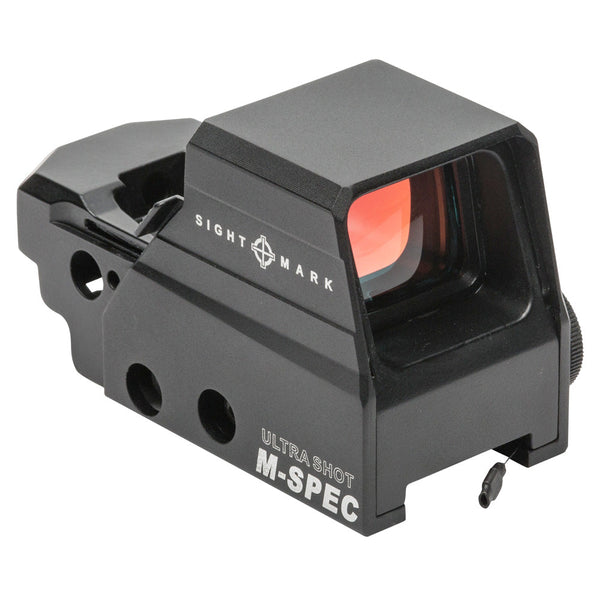Experienced shooters transitioning from iron sights or traditional scopes to red dot sights quickly learn one key difference: red dots run on batteries. Unlike a plain set of iron sights, a red dot’s illuminated reticle needs power. In high-pressure moments, the last thing you want is to hear trouble knocking at your door only to find your optic’s reticle dead.
Imagine a scenario: It’s late at night and you hear an intruder. You grab your firearm, aim, and… the red dot isn’t there because the battery died, leaving you with no reticle. It’s a nightmare scenario for anyone relying on a red dot in self-defense or critical situations. This is why battery life matters – a red dot sight is only as good as its ability to project a visible aiming point when you need it most.
For shooters transitioning to red dots from iron sights, it’s important to adjust habits you acquired from your iron-sight days. Now you have an electronic component to maintain. Fortunately, modern red dot optics boast exceptionally long battery lives, often tens of thousands of hours, thanks to efficient LED technology. To put it in perspective, many quality red dot sights today advertise 25,000+ hours of runtime (nearly 3 years continuous) on a single battery. Some Sightmark models go far beyond that, as we’ll discuss. But these impressive specs assume ideal conditions – and it’s up to you to optimize those conditions.
Tips to Preserve and Maximize Your Red Dot’s Battery
Even with a long-rated battery life, you should take steps to preserve power and avoid draining your optic unnecessarily. Here are some practical tips to get the most out of your red dot’s battery:
-
Use Appropriate Brightness: Run your red dot at the lowest brightness that still gives a clear aiming point for the environment. Cranking it to max power all the time will needlessly chew through battery life. In fact, running any optic at its highest setting continuously can shrink a “50,000 hour” battery claim down to a matter of days or weeks. Lower settings not only conserve energy, they often provide a crisper, non-bloated reticle (especially helpful in low light or for those with astigmatism). Save the high-intensity setting for bright daylight use only when needed.
-
Turn Off When Not in Use: If you’re storing your firearm or won’t be using it for an extended period, power down the optic. Many modern red dots have auto-off timers (for example, shutting off after 12 hours of inactivity) to save battery. If your sight has a motion-sensing “shake awake” feature, be mindful that it still relies on you leaving the power on initially. Don’t get complacent – always double-check that your optic is either off during storage or on and ready when kept for defense.
-
Regular Battery Checks and Replacement: Make it a habit to check your red dot’s brightness periodically. If it looks dimmer than usual, it could be a sign the battery is weakening. Experienced shooters often replace batteries on a schedule (e.g. every year) regardless of rated life, because a fresh $1 battery is cheap insurance for an always-ready sight. Keep a spare battery in your range bag or attached to the rifle (some optics or mounts even include battery compartments) so you’re never caught without power. And always use quality name-brand batteries to avoid leaks or premature failure.
-
Mind the Temperature: Extreme cold can reduce lithium battery efficiency, while excessive heat can shorten battery lifespan. If you operate in very cold environments, battery output might drop more quickly. Whenever possible, store and use your red-dot-equipped firearm within normal temperature ranges to maximize battery performance.
-
Leverage Power-Saving Features: Take advantage of any smart power features your optic offers. For instance, auto-dimming or ambient light sensors will adjust the reticle brightness to match conditions, avoiding unnecessary brightness (and battery drain) in low-light settings. Motion-activated illumination can help if you frequently forget to turn your optic off, though as mentioned, you must trust yourself to leave it on when it matters. If you have a solar-assisted optic (more on this below), make sure the solar panel is clean and exposed to light during use – it can greatly extend battery life by drawing from the sun when available.
By following these practices, you’ll stretch your red dot’s battery to its limits. But beyond user habits, the choice of optic itself plays a huge role. Sightmark has developed red dot sights specifically engineered for ultra-long battery life and reliability, so you never have to worry about that “no reticle” moment.
Innovations for Extended Battery Life in Sightmark Red Dots
Modern optics designers know that battery longevity is a top priority for shooters. Sightmark in particular has introduced models with game-changing battery performance, ensuring your red dot stays on for years, not hours. Let’s look at two standout examples and how they solve the battery life problem for good.
Mini Shot M-Spec M3 Solar: Harnessing Solar Power for 20,000+ Hours
Sightmark’s Mini Shot M-Spec M3 Solar is a prime example of using innovation to maximize battery life. This compact reflex sight features a top-mounted solar panel working in tandem with its battery. In normal use, the solar panel draws energy from sunlight (or even bright indoor light) to power the red dot’s 3 MOA reticle, relieving the battery’s workload. The result is an optic that can achieve up to 20,000 hours of continuous operation on a single CR1620 coin battery at medium brightness settings. To put that in everyday terms, that’s over 2 years of all-day, everyday use without a battery swap!
The M3 Solar automatically adjusts reticle brightness based on ambient light, meaning it never runs brighter than necessary. In bright sun, the solar panel and higher setting kick in; in dim conditions, it dials down to save power and avoid glare. This smart power management ensures the sight is always visible yet efficient. And even if you somehow eclipse that 20,000-hour mark, the solar assist acts as a backup – in daylight the sight can run directly off solar power if the battery is drained. Dual power options (solar + battery) give you extra peace of mind. It’s an ideal choice for shooters who want to “set it and forget it,” keeping their red dot on and ready for months on end without second thought.
The Mini Shot M-Spec M3 Solar is also built for reliability. Its fully enclosed, IP67 waterproof design means it’s ready for harsh conditions. But ultimately, it’s the battery endurance that shines. You’re likely to spend more money on gun oil than on replacement batteries for this optic. If you’re new to red dots, an optic like the M3 Solar removes the headache of constant battery checks – it’s always on when you need it, with a little help from the sun.
Wolverine Red Dots: A Battery Life That Outlasts the Shooter
If the M3 Solar’s 2+ year runtime sounds impressive, the Sightmark Wolverine series takes longevity to another level entirely. These robust tube-style red dot sights (available in models like the Wolverine FSR 1x28) are purpose-built for extremely low power consumption. The Wolverine can deliver an astonishing 1,000,000 hours of battery life on its lowest brightness setting. Yes, that’s one million hours – over a century of continuous operation! At a more practical medium setting (such as setting 6), it can run for about 6 years of continuous use on a single battery. In other words, you could leave a Wolverine running 24/7 and still expect consistent performance many years later.
The secret to this “lifetime” battery life is twofold: an efficient LED emitter and the choice of power source. Unlike most micro red dots that use small coin cells, the Wolverine is powered by a single AA battery – a common, inexpensive battery with a higher capacity. Combined with Sightmark’s efficient circuitry and an optional night vision mode (which uses very low output), the Wolverine sips power at an incredibly low rate. On low settings, it barely dents the battery’s charge, which is how it achieves that legendary runtime. In more practical terms, this means you can trust the Wolverine to be always on and ready, effectively removing battery anxiety from the equation.
Reliability is the Wolverine’s other strong suit. The optic’s housing is rubber-armored, constructed from a single piece of 6061-T6 aluminum, making it shockproof and waterproof. It’s built to withstand recoil and rough handling, so that ultra-long battery life isn’t cut short by anything else. For home defense or duty use, many shooters leave the Wolverine running at a moderate brightness full-time – knowing it will be ready at a grab without fumbling for power buttons, and that the battery inside still has years of life left. And if you do eventually need to swap the AA battery, replacements are ubiquitous and inexpensive. The Wolverine truly offers a battery life that lasts longer than you.
Always Ready: No More Dead Reticles
In the end, the goal for any red dot user is simple: never be caught with a dead reticle when you need it. By choosing quality optics with proven battery performance – and by following smart battery-preserving practices – you can make that goal a reality. Sightmark’s Mini Shot M-Spec M3 Solar and Wolverine red dots are two examples of how modern technology is eliminating the old worries about red dot battery life. Whether it’s through solar panels providing 20,000 hours of assist or ultra-efficient engineering yielding a million-hour marathon, you have options that fit your needs and shooting style.
To recap, keep your red dot’s brightness sensible, turn it off when appropriate, and don’t skimp on checking or changing your batteries on schedule. If you do, even the simplest always-on red dot will likely run for years without issue. And if you pair those habits with an optic designed for endurance – like Sightmark’s offerings – you’ll have the confidence that every time you shoulder your firearm, the red dot will shine bright. Don’t let a dead battery be your weak link. With the right preparation and the right sight, you can count on your red dot to be ready when trouble comes knocking, every time.
Frequently Asked Questions
How can I preserve and maximize my red dot's battery life?
You can preserve and maximize your red dot's battery life by using appropriate brightness settings, turning off the optic when not in use, and regularly checking and replacing the battery.
Why is it important to adjust habits when transitioning to a red dot sight?
It is important to adjust habits when transitioning to a red dot sight because now you have an electronic component to maintain, which requires different care compared to traditional iron sights.
What can happen if the battery of a red dot sight dies during a critical moment?
If the battery of a red dot sight dies during a critical moment, it can leave you without a reticle, compromising your ability to aim accurately in self-defense or other critical situations.
How long do modern red dot optics typically advertise for battery runtime?
Modern red dot optics typically advertise 25,000+ hours of runtime (nearly 3 years continuous) on a single battery, with some models exceeding that.
What are some practical tips for conserving battery life on a red dot sight?
Some practical tips for conserving battery life on a red dot sight include using appropriate brightness settings, turning off the optic when not in use, and regularly checking and replacing the battery.







